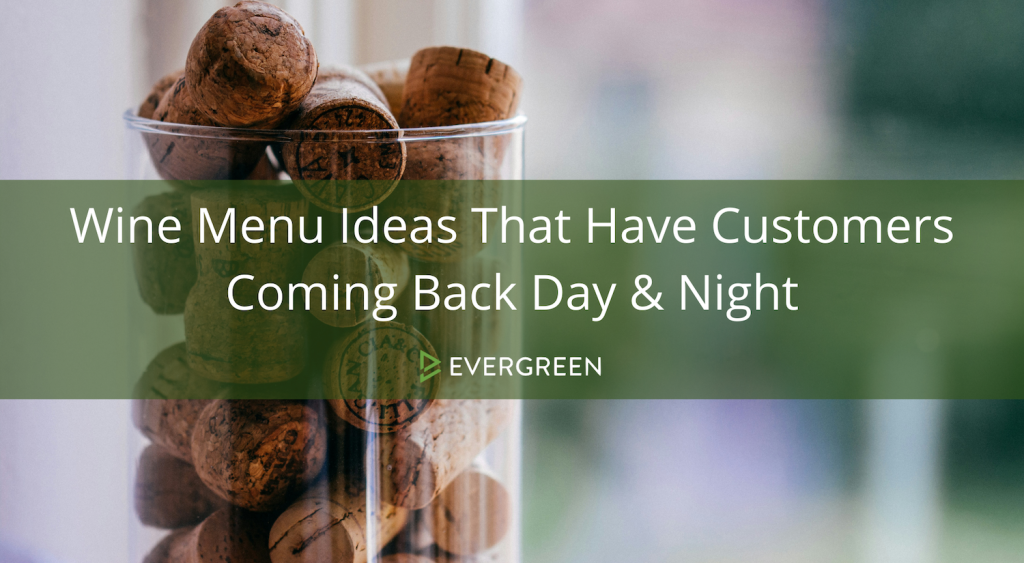Wine Menu Ideas That Have Customers Coming Back Day & Night

A well-curated wine menu is not just a list of beverages; it is an essential element of any restaurant or establishment that aims to provide an exceptional dining experience. The wine menu serves as a guide for customers, helping them navigate the world of wine and choose the perfect pairing for their meal. A thoughtfully curated wine menu can elevate the flavors of the cuisine, cater to different preferences, and enhance the overall dining experience.
By offering a well-curated wine menu, you provide your customers with a carefully selected range of options that suit different tastes and preferences. Whether they are wine enthusiasts or novices, they can explore new flavors, discover new favorites, and enhance their overall dining experience.
In this blog post we’ll explore tips for creating a well-rounded wine menu, wine pairing suggestions for different types of cuisine, best practices for wine menu design, and much more. By the end of this article, you will have a wealth of knowledge to create a wine menu that stands out and enhances the overall dining experience for your customers.
4 Strategies for Creating a Well-Rounded Wine Menu
Creating a well-rounded wine menu requires careful consideration and attention to detail. By following these tips, you can curate a wine menu that caters to your customers’ preferences, complements your cuisine, and sets your establishment apart from the competition.
- Consider the target customers, types of food served, and desired atmosphere when developing your next wine menu. If your establishment caters to a younger crowd, you may want to include more trendy and approachable wine options. On the other hand, if your target audience consists of wine enthusiasts, you may want to offer a selection of rare and unique wines that they can explore.
- It’s critical to include a variety of wine types in your menu. Red, white, rosé, and sparkling wines each have their own characteristics and can complement different dishes. For example, a light and fruity rosé can pair well with salads or light appetizers, while a bold and complex red wine can complement hearty meat dishes.
- Affordability is another crucial factor to consider when creating a well-rounded wine menu. It is important to offer affordable wines with a profit margin to cater to different budgets. This allows customers to enjoy a glass of wine without breaking the bank. By offering a range of price points, you can accommodate both customers looking for a budget-friendly option and those willing to splurge on a special occasion.
- Lastly, creating a unique wine list can help your establishment stand out from competitors. Consider adding popular wines from competitors to offer familiar options and attract customers. However, it is also important to include lesser-known wines or niche selections to cater to wine enthusiasts looking for new and exciting experiences.
By incorporating these tips into your wine menu creation process, you can curate a well-rounded selection that caters to your customers’ preferences, enhances the dining experience, and sets your establishment apart from the competition.
Wine Pairing Suggestions for Different Types of Cuisine
Pairing the right wine with specific types of cuisine can greatly enhance the dining experience. Here are some useful approaches:
- When selecting wines for different dishes, it is important to consider the flavors, intensity, and ingredients of the food. By understanding the characteristics of the cuisine and the wines, you can create harmonious pairings that elevate the flavors of both.
- If you have a menu that features dishes with earthy flavors, such as mushroom risotto or truffle pasta, red wines like Pinot Noir or Dolcetto can be excellent choices. These wines have earthy and fruity notes that complement the flavors of the dishes. The earthy flavors of the wine can enhance the earthiness of the mushrooms, creating a delightful harmony of flavors.
- On the other hand, if your menu includes fatty fish dishes like salmon or tuna, a rich and buttery Chardonnay can be a great pairing. The richness of the wine complements the fatty flavors of the fish, while the buttery texture adds a luxurious element to the pairing. This combination creates a balance of flavors and textures that can elevate the dining experience.
- When considering wine pairings, it’s wise to match the intensity and flavor profile of the food with the wine. For example, crisp and refreshing white wines like Sauvignon Blanc can pair well with dishes that have tart dressings or sauces, as the acidity of the wine complements the tartness. On the other hand, bold and robust wines like Malbec can complement dishes with sweet-spicy barbecue sauces, as the wine’s bold flavors can stand up to the intensity of the sauce.
- It’s also essential to consider personal tastes and preferences when choosing wine pairings. Some customers may prefer a light and crisp white wine with their seafood, while others may prefer a full-bodied red. By offering a variety of wine options and providing guidance on the menu, you can help your customers make informed choices and enhance their dining experience.
Incorporating wine pairing suggestions into your menu can be a valuable tool for your customers. By providing recommendations for each dish, you guide your customers towards the best wine choices that will enhance the flavors of their meal. This not only elevates their dining experience but also showcases your expertise and commitment to providing a memorable meal.
6 Ways to Choose Wines for Different Occasions or Events
Selecting wines for different occasions or events requires careful thought and consideration.
- The wine choices should be tailored to the time of day, formality of the event, and preferences of the attendees. By understanding these factors, you can create a wine menu that enhances the overall experience and leaves a lasting impression on your guests.
- If you are hosting a brunch event, you may want to offer light and refreshing options such as sparkling wines or light-bodied whites. These wines pair well with brunch favorites like eggs Benedict or smoked salmon, adding a touch of elegance to the occasion.
- On the other hand, for a formal evening event, you may want to offer a selection of red wines that pair well with rich and hearty dishes. This creates a sophisticated and indulgent dining experience for your guests.
- When it comes to main courses, it is essential to choose wines that can accommodate a range of preferences. Serving Rosé or sparkling wine as a safe option can ensure that there is a suitable wine choice for everyone. These wines are versatile and pair well with a variety of main course dishes, offering a delightful accompaniment to the meal.
- Offering different dessert wines can complement various types of desserts. A sweet and luscious late-harvest Riesling can pair well with fruity desserts, while a rich and nutty Tawny Port can be an excellent choice for chocolate-based desserts. By providing a selection of dessert wines, you can cater to different tastes and preferences, ensuring a satisfying end to the meal.
- To add an element of choice and personalization, consider opening 2-3 bottles of wine for guests to choose from. This allows them to select a wine that suits their individual taste and preferences. Additionally, if a guest brings their own wine, be gracious and open it to serve alongside your selection. This gesture demonstrates your commitment to providing a memorable experience and accommodating your guests’ preferences.
By selecting wines based on the occasion, preferences of the attendees, and the time of day, you can create a wine menu that enhances the overall experience and leaves a lasting impression on your guests. Taking the time to consider these factors shows your attention to detail and dedication to providing an exceptional dining experience.
5 Popular Wine Varieties and Their Characteristics
When curating a wine menu, it is crucial to include popular wine varieties that appeal to a wide range of tastes. Highlighting these varieties and their characteristics can help guide your customers and showcase the diversity of options available.
Here are some popular wine varieties and their characteristics:
- Pinot Noir: Pinot Noir is a red wine known for its delicate and complex flavors. It often exhibits notes of red berries, cherries, and earthiness.The light to medium body of Pinot Noir makes it a versatile pairing for a variety of dishes, including roasted poultry, grilled salmon, and mushroom-based dishes.
- Chardonnay: Chardonnay is a white wine that can range from crisp and refreshing to rich and buttery. It often displays flavors of citrus, tropical fruits, and vanilla. Chardonnay pairs well with fatty fish or fish in a rich sauce, as well as creamy pasta dishes and roasted chicken.
- Sauvignon Blanc: Sauvignon Blanc is a white wine known for its vibrant acidity and herbaceous flavors. It often exhibits notes of citrus, green apple, and fresh herbs. Sauvignon Blanc pairs well with tart dressings and sauces, as well as light seafood dishes and salads.
- Malbec: Malbec is a red wine with bold flavors and a velvety texture. It often displays notes of dark fruits, chocolate, and spice. Malbec pairs well with sweet-spicy barbecue sauces, as well as grilled meats and rich stews.
- Moscato d’Asti: Moscato d’Asti is a sweet and slightly sparkling white wine. It often exhibits floral aromas with flavors of ripe peaches and apricots. Moscato d’Asti pairs well with fruit desserts, as well as spicy Asian cuisine and soft cheeses.
By including these popular wine varieties in your menu, you provide your customers with a range of options that can cater to a variety of preferences. Additionally, highlighting the characteristics of each variety can help guide your customers in making informed choices that will enhance their dining experience.
Wine Menu Design: Ideas and Best Practices
The design of your wine menu plays a crucial role in attracting customers and showcasing the selection of wines available. A well-designed menu can entice customers to explore the wine offerings and make informed choices. Here are some ideas and best practices for wine menu design:
- Design visually appealing layouts: Use visually appealing layouts that catch the eye and make it easy for customers to navigate the menu. Categorize the wines clearly, such as by type (red, white, rosé, sparkling), region, or flavor profile. This allows customers to find their preferred wines quickly and efficiently.
- Provide brief descriptions or tasting notes: Include brief descriptions or tasting notes for each wine to provide customers with a glimpse of the wine’s characteristics. This can help them make informed choices based on their preferences. Keep the descriptions concise and easy to understand, highlighting the key flavors and characteristics of each wine.
- Use appropriate fonts, colors, and imagery: Use fonts and colors that are consistent with your establishment’s branding and overall aesthetic. Consider using imagery that evokes the essence of wine, such as vineyard landscapes or wine glasses. These design elements contribute to an aesthetically pleasing menu that reflects the sophistication and quality of your wine offerings.
- Incorporate popular wines from competitors: To offer familiar options and attract customers, consider incorporating popular wines from competitors into your menu. This allows customers to find wines they are already familiar with while also discovering new and unique selections in your menu.
By following these ideas and best practices, you can create a wine menu that is visually appealing, easy to navigate, and showcases your selection of wines. A well-designed menu enhances the overall dining experience and entices customers to explore and try different wines.
Incorporating Affordable Wines without Compromising Quality
Offering affordable wines on your menu is essential to cater to a wide range of budgets. Customers appreciate having options that suit their financial constraints without compromising on quality. Here are three strategies for incorporating affordable wines without compromising quality:
- Negotiate favorable pricing with suppliers: Establish good relationships with wine suppliers and negotiate favorable pricing for affordable wines. Buying in bulk or committing to regular purchases can often lead to discounted rates. This allows you to offer affordable wines that still meet your quality standards.
- Consider alternative wine regions: Explore wine regions that may offer excellent quality wines at more affordable prices. For example, regions like Argentina and Chile are known for producing high-quality wines at a fraction of the cost of some European counterparts. By including wines from these regions in your menu, you can offer affordable options without compromising on taste.
- Offer a range of price points: Create a wine menu that includes a range of price points to accommodate different customers. This can include affordable options as well as higher-priced selections for those looking to indulge. By offering a variety of price options, you can cater to a wider customer base and ensure that there is something for everyone.
3 Musts for Standing Out with a Unique Wine List
In a competitive market, having a unique wine list can set your establishment apart from others. Offering a selection of wines that is distinct and different from what customers might find elsewhere can be a compelling reason for them to choose your establishment. Here are some ideas to create a unique wine list:
- Offer niche or lesser-known wines: Include wines that are not commonly found in other establishments. This can include wines from lesser-known regions or unique varietals. By offering these niche options, you provide customers with the opportunity to explore new flavors and expand their wine knowledge.
- Highlight exclusive wine selections: If you have access to exclusive wines or limited releases, showcase them in your wine list. These wines can create a sense of excitement and exclusivity for customers, making them feel that they are experiencing something special.
- Provide detailed information: Alongside each wine, provide detailed information about its origin, production methods, and flavor profile. This helps customers understand the story behind each wine and appreciate the craftsmanship that goes into its creation. It also allows them to make more informed choices based on their preferences.
By creating a unique wine list, you differentiate your establishment from competitors and create a compelling reason for customers to choose your wine offerings. A unique wine list not only enhances the dining experience but also showcases your commitment to providing something special and memorable.
Proper Wine Storage and Service
Proper wine storage and service are essential to maintain the quality and integrity of the wines you offer. By following best practices, you can ensure that your customers receive wines that are at their best and enjoy an exceptional dining experience. Here are some key considerations for proper wine storage and service:
- Store leftover wine properly: If wine is left unfinished, it is important to store it properly to maintain its freshness and flavor. Pour the remaining wine into a smaller bottle, cork it tightly, and store it in the refrigerator. This helps slow down the oxidation process and preserves the wine for future use.
- Serve wine at the appropriate temperature: Different types of wines should be served at different temperatures to showcase their flavors and aromas. It’s common to see red wines served slightly below room temperature, whereas white wines and sparkling wines are served chilled. By serving wines at the appropriate temperature, you ensure that your customers can fully enjoy the flavors and characteristics of each wine.
- Consider aerating young red wines: Young red wines, especially those with high tannin content, can benefit from aeration. This process involves exposing the wine to air to soften the tannins and enhance the flavors. Consider using a decanter or allowing the wine to breathe in the glass before serving. This can significantly improve the taste and enjoyment of the wine.
By following these practices, you can ensure that the wines you serve are of the highest quality and deliver an exceptional dining experience. Proper storage and service demonstrate your commitment to providing the best possible wine experience for your customers.
An excellent wine menu is an essential component of any establishment that aims to provide an exceptional dining experience. By following these tips for creating a well-rounded wine menu, offering wine pairing suggestions for different types of cuisine, incorporating affordable wines without compromising quality, and creating a unique wine list, you can create a wine menu that stands out and enhances the overall dining experience for your customers.
Want to boost your wine menu’s performance as soon as next week? Check out our tools and impress your customers every time. Book your demo now!


